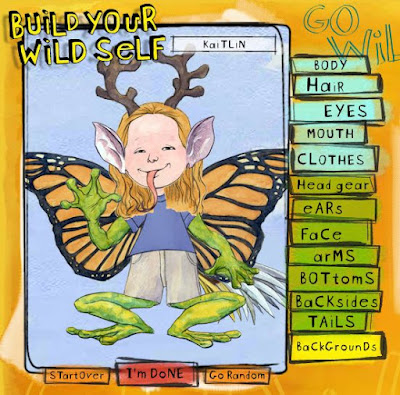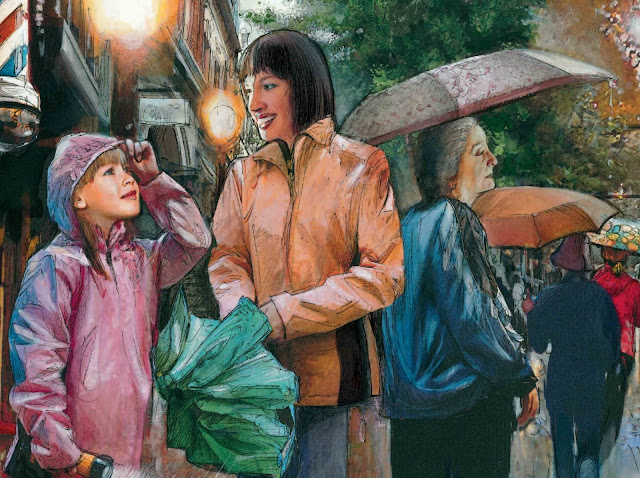I always think summers are a time to do something different. So I want to share the story of one book's journey. Trust me, books--mine at least--take more than 9 months from inspiration to birth (aka publication).
This is the story of Toad Weather.
As I look back on my different versions of that story, it goes all the way back to 2002 when I first wrote a version of it. Truth-be-told the idea sparked in my brain a few years ahead of that. I remember being in New York City on a rainy day. I was impressed with how the rain changed the city sounds and smells--not in a bad, stinky way but a heightened-interestingly different way. I loved watching the raindrops plopping, rivers swirling along the curbs, people splashing through puddles. And I remember thinking that I hadn't read a children's picture book about exploring a rainy day.
Along about 2002 after the images of NYC on that rainy day kept popping up in my mind, I wrote the first version of what I called Rain, Rain, Come Again! Not a very original title but OK for WIP. And the opening went like this:
I watched the raindrops wiggling down the window and thought of all the things I couldn’t do.
“What’s this long face?” Mom asked.
“Can’t you see it’s a perfectly, wonderful rainy day?”
When I said, “No,”
she bundled us both up in slickers and boots.
Then we went down the elevator,
through the apartment building’s lobby,
out the revolving door,
and into the rainy city.
I tried to sell my brand new book but it didn't sell. Still, the idea stuck with me. Kept niggling my imagination to try another version.
Who knows how many versions I did try after that but some time later by September 29, 2011 I was calling it Rain Come Again! By now, I was visualizing the illustrations in my head and dividing the text into left-right page spreads. And here was what the opening had become.
L-R pp. 2-3
Raindrops
slip,
slither,
race
down the window.
Outside, the whole world is sloppy wet.
“I hate rainy days,” I say.
Mom says, “Come with me. I’ve something to show you.”
LR pp 4-5
She bundles us up in slickers and boots.
Then we go down the elevator,
out the door,
and into the rainy city.
Still didn't sell. SIGH!!!!
But I wasn't giving up. Or this story wasn't giving up on me. Both would be true.
I don't see any versions from 2012 so I must have left it to brew in my brain in between working on other projects. And life in general.
But brew it did.
Here's the beginning again from where I was with the story on August 20, 2013 (In case you haven't picked it up by now, I date every version so I know what's current. Also lets me go back if I think I might have had a better bit a while back.) Title is still Rain Come Again!
L-R pp. 2-3
In the gloomy-gray of that March evening
while the spring rain that started yesterday keeps falling,
I sit on the window seat and watch the wet city.“I hate rainy days,” I say.
Behind me, Grandma sighs. “Me too.”
Then Mama bursts into our apartment.
L-R pp 4-5
She’s beaming. “I rushed home to get you,” Mama says. “Come on, Alli. You too, Grandma. We’re going outside. I’ve something to show you.”
“Is it safe to go out in the rain?” I ask.
“It’s getting dark,” Grandma says.
“It’s still light enough and it’s not lightning,” Mama says. “Now get ready. This surprise is too good to miss.”
“I think I’ll stay home,” Grandma says. But Mama bundles us both into slickers and boots. Then we go down the stairs,
out the door, and into the rainy-day city.
Hey! I'm liking the feel of this. There's that poetic prose beat that just sings to my soul starting to get in there. I've introduced a new character-Grandma. I like her. She has a bit of a grumpy attitude that's a nice foil for upbeat Mama. Okay--worth polishing this version a bit and then send it back out in the world for consideration.
Shoot off the fireworks!
Some time in mid-2013--and probably a solid 20-something versions later--Peachtree Publishers blessed me by deciding to publish my exploring a rainy day picture book. They felt it had potential. But--and I agreed--it still needed some work because it needed a hook--something to discover besides that a rainy day is cool.
I went digging for my hook. What in the world happens that is really special on a rainy day? Or maybe happens once a year on a rainy day? OK--maybe I'm onto something there.
I did some digging into that second possibility because I remembered reading something about toads while working on another book Slippery, Slimy Baby Frogs. Of course, being about toads it hadn't made it into that book but HEY!
I dug into my files. Found my amphibian expert. Gave him a call. Yep! I was onto something because once a year toads migrate in Roxborough, Pennsylvania. They do it every spring on a rainy night. And it's a big deal that even makes the news because people turn out to help the little toads cross a busy highway on their way to a nearby reservoir where they'll mate and leave their eggs to hatch.
My story just moved to Roxborough, Pennsylvania and found its hook.
It was still called Rain Come Again! but as of November 21, 2013 the story was settling in and the beginning had become this.
pages 4-5
In the gloomy-gray
the spring rain keeps falling.
I press my nose to the window.
But there’s nothing to see outside
except the rain-soaked city.
No chance to go to the park after school. Or ride my bike.
Rainy days are boring.
“I hate rainy days,” I say.
Grandma sighs. “Me too.”
pages 6-7
Then Mama bursts into the apartment.
“Come on, Alli,” she says. “You too, Grandma. We’re going outside.
I saw something on the way home. It’s not far. I want to show you.”
“Really?” I jump up.
“What is it?” Grandma asks. “What’s so special that we have to get wet?”
Besides, it’s getting late.”
“It’s still light enough.” Mama hands us our slickers and boots.
“Come on. Get ready. And we’ll go.”
“I think I’ll stay right here, thank you,” Grandma says.
pages 8-9
But Mama says, “Please. Come with us.”
So Grandma puts on her slicker too. We hurry down the stairs,
and out into the rainy nearly-nighttime.
My main character who will discover what's so special out there now has a name and I'm feeling her--starting to experience the story through her.
Grandma has a permanent place in the story and is, I must say, getting saucy. But she doesn't want to miss out on the action, which adds to the momentum that's picking up nicely now in the opening.
There were maybe another 10 versions as I tweaked and whittled and polished the words. Then the line breaks to give just the right pacing to the language. Next, the verbs to power them up. And the dialog so each character's words were just right for her--my three generations of women sharing this special rainy night discovery.
I'm not sure when the title changed but I see on my August 20, 2014 version it's now--finally-- Toad Weather. And the beginning was this.
pages 4-5
In the gloomy-gray
of a March day
the spring rain keeps falling.
I press my nose to the window.
But there’s nothing to see outside
except the rainy-weather city.
No chance to go to the park,
ride my bike,
or play outside with my friends.
“Rainy weather makes me sad,” I say.
Grandma sighs. “Me too.”
pages 6-7
Then Mama bursts into the apartment.
“Come on, Ally,” she says.
“You too, Grandma. I saw something on the way home,
something I want to show you.”
“Really?” I jump up.
“What’s so special that we have to get wet?”Grandma asks. “Besides, it’s getting late.”
“It’s still light enough.”
Mama hands us our slickers and boots.
“Come on. Get ready. Let’s go.”
“I think I’ll stay right here, thank you,” Grandma says.
But Mama says, “Please.
Come with us.”
pages 8-9
streetlights are glowing.
So are shop windows.
But the world is soggy dreary.
All around us people are hurrying through the drizzling rain.
Cold drops slip down my neck,
so I pull my slicker hood over my head.
Then I start to hurry too,
and Grandma keeps up with me.
“Slow down, you two!” Mama says.
“There are lots of interesting things to see along the way.”
“Like what?” Grandma asks.
Is that what the final language is in the published book that was born to the world in 2015? I'll let you look and see for yourself if it changed any more.
My point--made at great length, I admit--is that a book like any baby needs time to develop. If the idea sticks with you, if you keep coming back to it because you just have to get it right, if it's something that feels a little better every version you write...
Keep at it.
For one thing, honestly, you, me, we writers grow our skills through writing, reading, listening, thinking words into the rhythm of our fiction, nonfiction and faction--that in between real and really imagined like Toad Weather.
Let me repeat the all important message here. KEEP AT IT!
With Very Best Wishes! Sandra Markle
































































